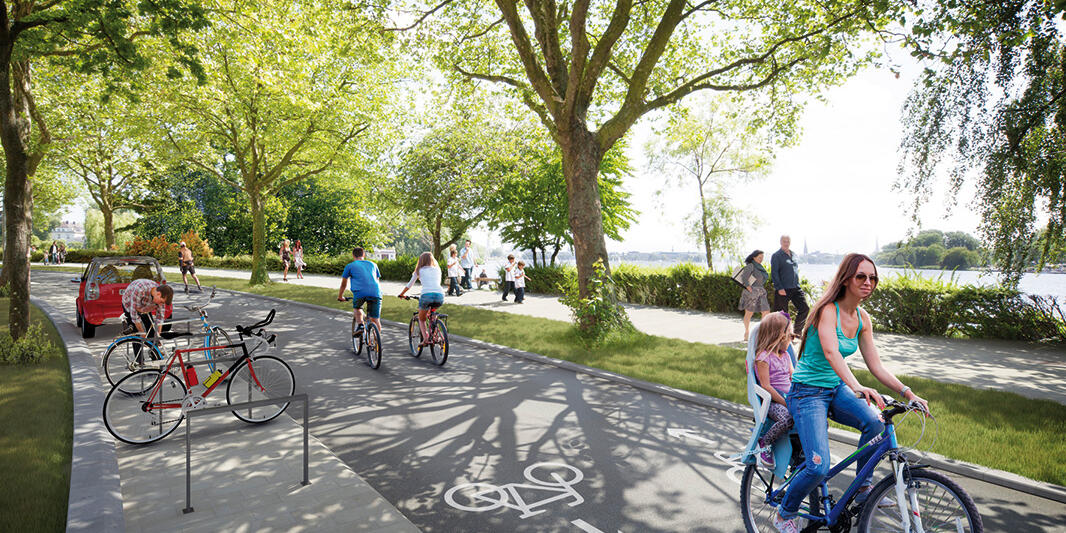
The right bike is something that you have to find for yourself. For longer tours, street gear like mudguards and dynamos including continuous lighting are recommend. If you are planning a day trip, a city bike will suffice. If you’d like to embark on a tour over several days with all your baggage, a special touring bike is beneficial. If you don’t have your own, or don’t want to bring it with you, a high-quality rental is a good alternative.
Posture is also important: straight back, fully extended legs - your local bike shop can help you find the ideal posture for longer trips.
Basic equipment
Bike lock replacement inner tube/repair kit drinking bottle air pump and repair tools, rags, replacement parts for breaks and switches
Horn grips
Horn groups - for MTBs and anyone without racing handlebars. You can change position more often, reducing strain on the tendons in your arms. Anatomically designed grips bounce up and down and massage you to prevent your veins from getting stuck.
Saddle
If it hurts, you need a new saddle. There’s a lid for every pot - and the same goes for saddles. Women should opt for women’s saddles and try out the narrow, hard-looking racing saddles. Good retailers may let you test drive a saddle.
Pedals
Pedals with cages are useful, as they hold you in and prevent you from falling off the pedal. You can also transfer more power through the pedal, as you can push and pull. Click pedals are even better. Suitable for cyclists travelling 70-80km a day and ideal for steep mountain inclines.
You can easily release the holder, and you’ll get used to it after a few miles. You’ll no longer think about the pedals when mounting or dismounting anymore - just “click” and you and your bike are one. SPD pedals, as the system is called, are more secure than cages, especially in emergencies - emergency braking or even falls - as you can easily remove yourself from the pedals.
Tools
The ADFC offers a good overview here.
Holiday bike service
Tyre wear, screws and connections, brake rubber and all gears, even the ones you rarely use! - should all be tested under stress (apply breaks and switch gears).
Before every tour, check that your tyres and lights are in good working order. Are all the screws tight? Can the breaks stop even a fully loaded bicycle? A professional service can prevent any nasty surprises, and it’s often cheaper than you’d expect.
You’ll find a number of workshops all along the Elberadweg, and hosts will often have tools at the ready. However, don’t forget your own repair set including replacement inner tube and spares for your gear switcher and brakes.
Panniers
Proper distribution is the key here. Take two separate (!) panniers for the back, and hang a handlebar bag from the front to hold anything you might need on hand.
Low-rider panniers for the front of the bike are not just for hardcore cyclists. As your riding position is sensitive to change, even distribution of weight can have a palpable effect. Try it for yourself.
Your bags should be waterproof, made from a tear-resistant material and attached to your bike at several places. Quality is key, e.g. from the brand starting with “O”. Other baggage such as a tent or sleeping bag (in a water-proof bag) should be tied to your baggage racks with rubber bungee spiders. These are made up of several bungee ropes so they’re perfect for securing all nooks and crannies.
Road safety
Light up your bike! And don’t forget indicators for the back. Make sure that your bags don’t cover your back light. Put your lights on as soon as it starts to get dark! Light clothing with reflective strips. A high-vis jacket might get dirty quickly but will make sure you’re visible. Leg cuffs won’t do much if you have panniers on the side of your bike, but are otherwise very effective as they are constantly moving.
Odometer
For orientation and estimating where you are. Also shows cycling time, so you can see when to take a break: every 2 hours.
